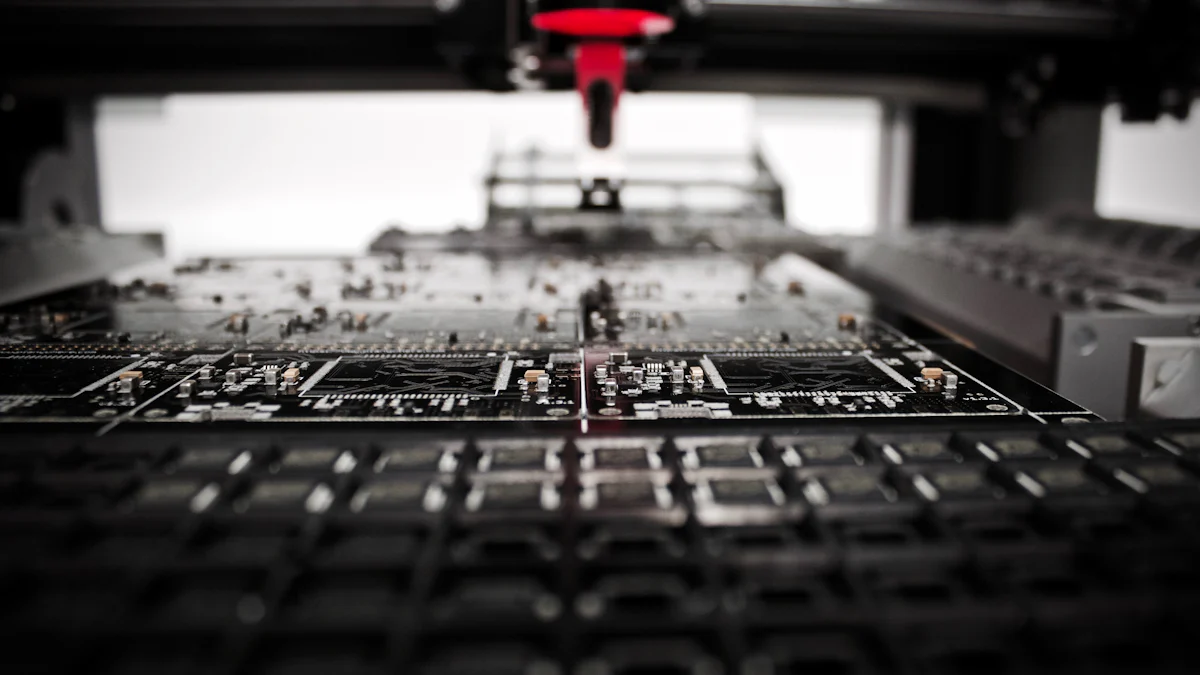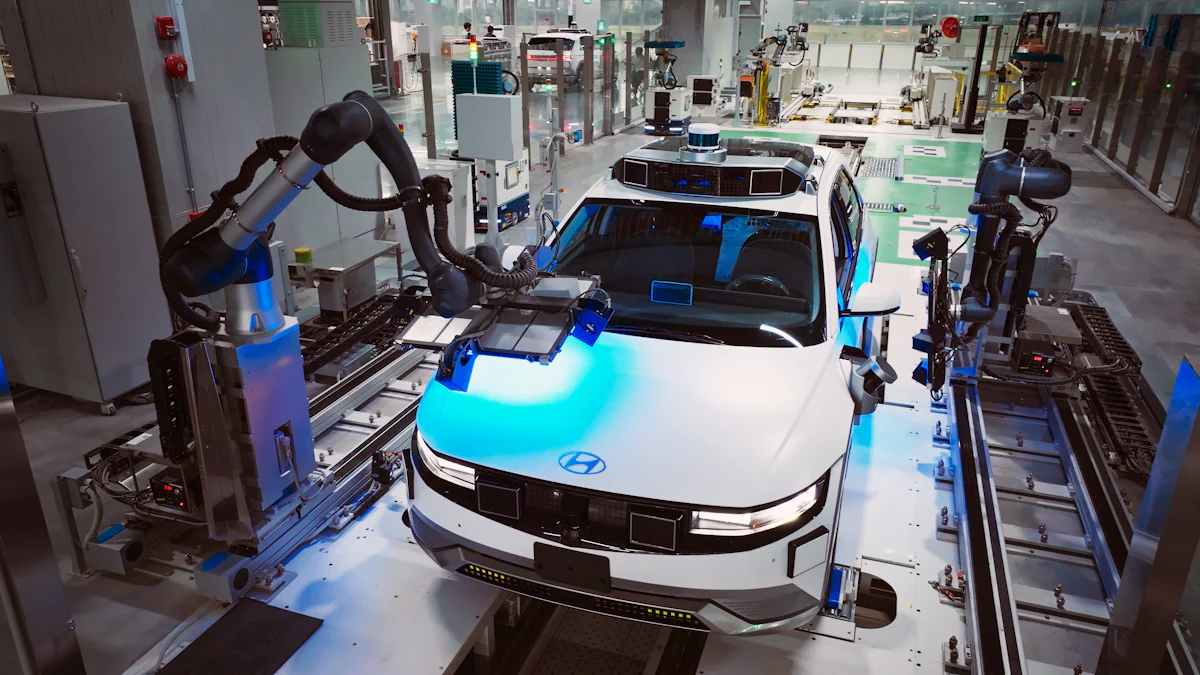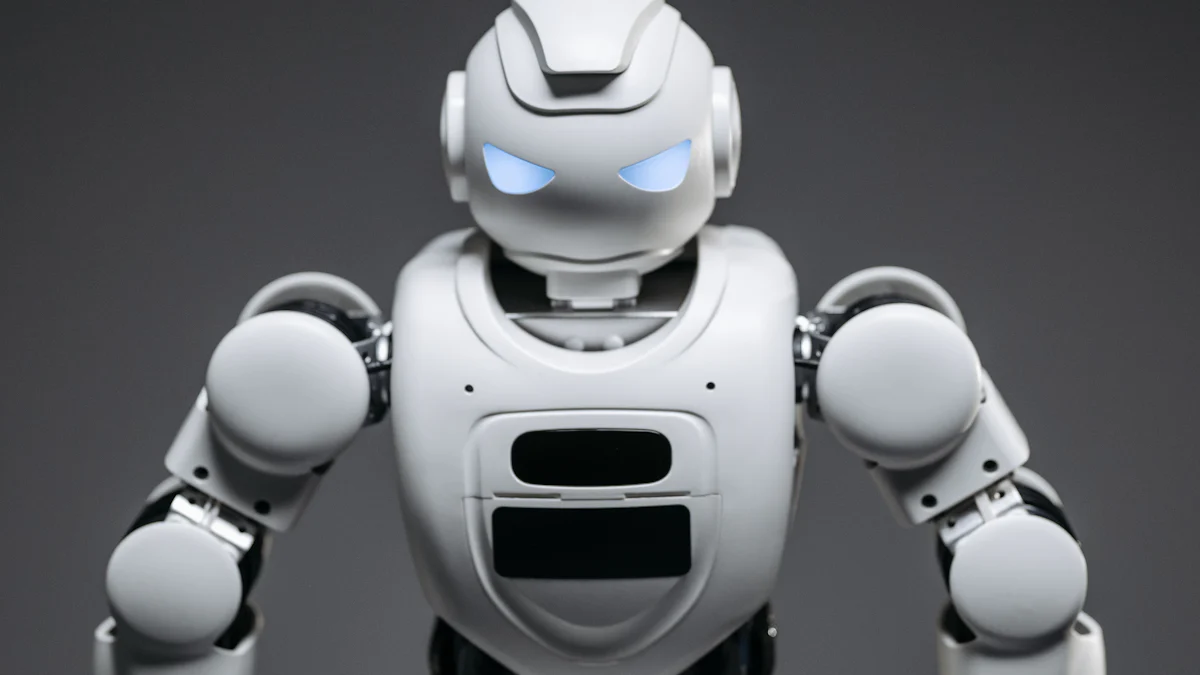AI-Powered Robotics Transforming Assembly Lines in Electronics Manufacturing

Robotics has revolutionized manufacturing, driving significant advancements in efficiency and productivity. AI enhances robotic capabilities by enabling complex decision-making and autonomy. The electronics manufacturing industry benefits immensely from these innovations, with AI-powered robots improving precision, speed, and adaptability on assembly lines. Recent manufacturing news highlights the rapid growth and integration of AI in robotics, showcasing its transformative impact on production processes.
Historical Context of Robotics in Manufacturing
Early Use of Robotics
Initial Automation Efforts
The journey of robotics in manufacturing began in the mid-20th century. In 1954, George Devol designed the first programmable robot. This innovation led to the development of Unimate, considered the first 'true' industrial robot in history. Unimate made its debut on a production line at the GM Ternstedt plant in Trenton, NJ. The robot automated body welding operations, significantly boosting productivity.
Robots were first used commercially on assembly lines in the early 1960s. These initial automation efforts aimed to enhance efficiency and reduce manual labor. The introduction of robots marked a significant shift in manufacturing processes, setting the stage for a prolonged period of robotics development.
Limitations of Early Robotics
Early robotics faced several limitations. The technology lacked advanced sensors and computing power. Robots could perform only repetitive tasks with limited precision. High costs and technical complexities restricted widespread adoption. Despite these challenges, early robotics laid the groundwork for future advancements.
Evolution with AI Integration
Introduction of AI in Robotics
The integration of artificial intelligence (AI) into robotics marked a new era in manufacturing. AI enabled robots to perform complex decision-making and adapt to dynamic environments. The introduction of AI in robotics transformed assembly lines, enhancing efficiency and flexibility.
AI-powered robots could learn from data and improve over time. This capability allowed for real-time adjustments and optimization of manufacturing processes. The integration of AI also facilitated predictive maintenance, reducing downtime and operational costs.
Milestones in AI-Powered Robotics
Several milestones highlight the evolution of AI-powered robotics. Companies like Alibaba, Lenovo, and Huawei invested heavily in AI to upgrade their manufacturing operations. For instance, Alibaba plans to integrate AI models into all its products, showcasing the transformative impact of AI on production processes.
AI-powered robots now play a crucial role in quality control, real-time monitoring, and defect detection. These advancements have significantly improved product quality and reduced waste. The ability to customize assembly lines and handle complex tasks has further enhanced the adaptability of manufacturing systems.
Recent manufacturing news highlights the rapid growth and integration of AI in robotics. The electronics manufacturing industry benefits immensely from these innovations. AI-powered robots continue to revolutionize assembly lines, driving significant advancements in efficiency, precision, and productivity.
Current Applications of AI-Powered Robotics

Enhancing Efficiency
Precision and Accuracy
AI-powered robots excel in precision and accuracy. These robots utilize advanced sensors and machine learning algorithms to perform tasks with high precision. Electronics manufacturing requires exact placement of components. AI-powered robots ensure this accuracy, reducing errors and improving product quality. The integration of AI allows robots to adapt to minor variations in the assembly process, maintaining consistent performance.
JUSDA has been actively integrating AI into its supply chain management solutions, particularly through its JusLink Technology Platform. One notable AI product developed by JUSDA is the JusAI Intelligent Dialogue Engine. This engine leverages large language models to revolutionize traditional logistics operations, allowing users to access services through a single window, perform one-click Q&A, and view all interactions with the chatbot. This innovation provides accurate, rapid, and low-cost services, enhancing the overall service experience for customers and opening new possibilities for intelligent supply chain management.

SMART JusLink
Supply Chain Management Solution
Additionally, JUSDA is exploring the integration of traditional machine learning models. In collaboration with the Ningbo MIT Ning Chuang Academy, JUSDA has developed the AI Dynamic ETA Intelligent Algorithm. This algorithm uses machine learning, neural network models, dynamic/static prediction models, and ETA prediction models to integrate vast amounts of vessel data, thereby predicting arrival times at destination ports more accurately. This advancement significantly enhances supply chain operational efficiency by providing timely and accurate logistics anomaly warnings, improving operational efficiency, reducing costs, and mitigating the risk of supply chain disruptions.
Speed and Productivity
Speed and productivity are critical in electronics manufacturing. AI-powered robots operate at higher speeds than human workers. These robots can work continuously without fatigue, significantly boosting productivity. The ability to quickly reprogram AI-powered robots for different tasks enhances their utility on assembly lines. This adaptability leads to faster production cycles and increased output, meeting the growing demand in the electronics industry.
Quality Control
Real-time Monitoring
Real-time monitoring is essential for maintaining high-quality standards. AI-powered robots equipped with vision systems and sensors provide continuous monitoring of the assembly process. These robots detect anomalies and deviations from the standard process in real-time. Immediate identification of issues allows for prompt corrective actions, minimizing defects and ensuring consistent product quality.
Defect Detection and Correction
Defect detection and correction are vital for reducing waste and improving efficiency. AI-powered robots use machine learning algorithms to identify defects that may not be visible to the human eye. These robots analyze data from multiple sources to detect patterns indicative of potential defects. Once detected, AI-powered robots can either correct the defect or alert human operators for intervention. This capability significantly reduces the rate of defective products, enhancing overall production quality.
Flexibility and Adaptability
Customization of Assembly Lines
Customization of assembly lines is a significant advantage of AI-powered robotics. Traditional assembly lines lack flexibility, making it challenging to adapt to new products or changes in design. AI-powered robots can be easily reprogrammed to handle different tasks and configurations. This flexibility allows manufacturers to quickly adapt to market demands and customize products according to customer specifications.
Handling Complex Tasks
Handling complex tasks is another area where AI-powered robots excel. Electronics manufacturing involves intricate processes that require high levels of dexterity and precision. AI-powered robots can perform these complex tasks with ease. These robots use advanced algorithms to plan and execute complex movements, ensuring accurate assembly of intricate components. The ability to handle complex tasks enhances the overall efficiency and capability of the manufacturing process.
Challenges and Solutions
Technical Challenges
Integration with Existing Systems
Integrating AI-powered robots with existing systems presents significant challenges. Legacy systems often lack the compatibility needed for seamless integration. Manufacturers must invest in upgrading infrastructure to support advanced robotics. This process requires careful planning and substantial resources. The complexity of integrating new technologies can lead to operational disruptions.
Data Management and Processing
Data management and processing pose another technical challenge. AI-powered robots generate vast amounts of data. Managing this data efficiently is crucial for optimal performance. Manufacturers need robust data storage solutions and advanced analytics tools. Processing large datasets in real-time demands high computational power. Ensuring data security and privacy adds another layer of complexity.
Economic and Social Challenges
Cost of Implementation
The cost of implementing AI-powered robotics remains a significant barrier. Initial investment in robotics technology is high. Small and medium-sized enterprises may struggle to afford these costs. Ongoing maintenance and upgrades add to the financial burden. Manufacturers must weigh the long-term benefits against the upfront expenses.
Workforce Displacement and Training
Workforce displacement is a major social challenge. AI-powered robots can perform tasks previously done by humans. This shift can lead to job losses and economic instability. Training programs are essential to help workers adapt to new roles. Upskilling the workforce ensures that employees remain valuable assets. Manufacturers must invest in education and training initiatives.
Solutions and Innovations
Advances in AI Algorithms
Advances in AI algorithms offer promising solutions. Improved algorithms enhance the capabilities of AI-powered robots. These advancements enable better decision-making and adaptability. Enhanced machine learning models improve predictive maintenance. Manufacturers benefit from reduced downtime and increased efficiency.
Collaborative Robotics (Cobots)
Collaborative robotics, or cobots, represent an innovative solution. Cobots work alongside human operators, enhancing productivity. These robots handle repetitive tasks, allowing humans to focus on complex activities. Cobots improve workplace safety by performing hazardous tasks. The integration of cobots fosters a collaborative environment.
Future Prospects

Emerging Technologies
Machine Learning and Deep Learning
Machine learning and deep learning are revolutionizing robotics. These technologies enable robots to learn from vast amounts of data. This learning process allows robots to improve their performance over time. Advanced algorithms help robots make complex decisions independently. Forbes highlights that machine learning enhances robotics by interpreting data and adapting to new situations. Industrial robots now use advanced sensors and machine learning software to become more autonomous.
Deep learning algorithms further enhance robot capabilities. These algorithms allow robots to recognize patterns and make predictions. Robots can now perform tasks that require a high level of intelligence. The integration of deep learning in robotics promises transformative changes across multiple sectors. Robots can handle more complex tasks with greater efficiency.
Internet of Things (IoT) Integration
The Internet of Things (IoT) is another emerging technology transforming robotics. IoT enables robots to connect with other devices and systems. This connectivity allows for real-time data exchange and communication. Robots can now receive updates and instructions remotely. IoT integration enhances the flexibility and adaptability of robots.
AI and IoT together drive the evolution of robotics. Standard Bots reports that these technologies turn robots into intelligent partners. Robots no longer serve as mere tools for repetitive tasks. Instead, they become active participants in manufacturing processes. IoT integration also improves predictive maintenance. Robots can monitor their own performance and predict potential issues. This capability reduces downtime and increases operational efficiency.
Potential Impact on the Industry
Increased Automation
Increased automation represents a significant impact on the electronics manufacturing industry. AI-powered robots take over repetitive and mundane tasks. This shift allows human workers to focus on more complex activities. Enhanced automation leads to higher productivity and efficiency. Companies like Alibaba and Lenovo invest heavily in AI to upgrade their operations. These investments showcase the transformative impact of AI on manufacturing processes.
Robots equipped with AI can operate continuously without fatigue. This capability boosts production rates and meets growing market demands. Increased automation also improves product quality. AI-powered robots ensure precision and accuracy in every task. The electronics manufacturing industry benefits immensely from these advancements.
New Business Models
New business models emerge as a result of AI-powered robotics. The Consumer-to-Manufacturer-to-Consumer (C2M2C) model exemplifies this trend. This model starts from consumer demand and influences the upstream supply chain. On-Time International Supply Chain Management Co., Ltd. introduced this innovative approach. The C2M2C model drives orders based on demand and prompts continuous adjustments in production plans.
Agile supply chains become more prevalent with AI-powered robotics. Manufacturers can quickly adapt to changing market conditions. Customization of products becomes easier and more efficient. New business models foster a more flexible and responsive manufacturing environment. The electronics industry stands at the forefront of these transformative changes.
AI-powered robotics have revolutionized electronics manufacturing. These technologies have enhanced efficiency, precision, and adaptability on assembly lines. AI-driven robots have transformed quality control and real-time monitoring, ensuring superior product quality.
The potential for continued innovation remains vast. Emerging technologies like machine learning and IoT integration promise further advancements. Companies investing in AI will likely see significant improvements in productivity and revenue.
The future of electronics manufacturing looks promising. AI-powered robotics will continue to drive automation and create new business models. The industry stands on the brink of a transformative era.
See Also
Maximizing Efficiency: Warehouse Automation Unveiled
Uncovering Robotics Innovation: Logistics Transformation
Logistics Robotics Impact: Boosting Warehouse Efficiency
Automated Future: Benefits of High-Tech Manufacturing Warehouses
Advanced Manufacturing: Dispelling Automation Misconceptions
